There are few things that can disrupt the enjoyment of your 4th of July picnic as much as the constant annoyance caused by uninvited guests – namely flies. Because this holiday weekend is now upon us, I thought it appropriate to outline a few simple measures that can help to alleviate this problem in a safe and sane manner.
First, a little background on our perspective of insecticides (and other toxic compounds). As we look around at our friends, family and neighbors, we see a distressing occurrence that crops up with an alarming regularity – individuals diagnosed with cancers of various types. I suppose if we knew why this was occurring then the medical community would have already found ways to prevent such occurrences. But that is not the case. One by one, researchers identify compounds that appear to be carcinogenic, and in a piecemeal way, these compounds are either restricted or taken off the market. But in the meantime, we seem bent on solving many of our problems with the use of toxic chemicals. Have you got a problem with insects in the house? Have a pest control company spray the premises every other month. Are dandelions and crabgrass overtaking your beautiful dichondra lawn? No problem, Ortho has a host of chemicals that you can spray to control these nuisances. Tired of having to clean up brush that inevitably grows along your fence lines? Roundup to the rescue. Just spray the unwanted growth and it will no longer be a problem. How about those pesky chiggers and ticks, do they bother you also? The solution is right on the shelves of your local convenience store. Saturate your clothes with a magic chemical solution, and then slather your skin with DEET (a chemical that destroys the functioning of an insect’s central nervous system).
When you examine the label of any of these products, do you really know what all those 17 syllable words mean, and what serious long-term studies on their safety have actually been conducted? It seems to me (based only on gut-feelings, I confess) that we have become so complacent in the use of toxic chemicals and compounds to solve a myriad of common problems, that we don’t even think of the possible consequences of exposure to these items any more. When was the last time you saw a weekend gardener wearing a haz-mat type suit when spraying or dusting their tomatoes? Never, I’ll be willing to bet. And yet, if you carefully read the labels on these products, you will find all kinds of serious warnings, along with application recommendations that go unread or ignored. Meanwhile, people seem to be dropping left and right from cancers and diseases that we cannot say for certain what is the causation. It is in this light that I offer a few recommendations for the control of fly populations around the small hobby farm or ranch.
The first recommendation is to manage animal manure. It is a task that is not the most pleasant to perform, but is necessary in order to control the breeding of flies, and is also vital to the health of your animals. In the hen house, consider using wood chips on the floor. By laying a sufficiently deep layer of wood chips, and frequently turning the chips with a rake or shovel, you are in effect composting the litter, thus depriving flies of their favorite breeding material.  In the following photograph, you can see that we have created a 6″-12″ bed of cedar chips on the floor, which serves as both a compost medium and deodorizer.
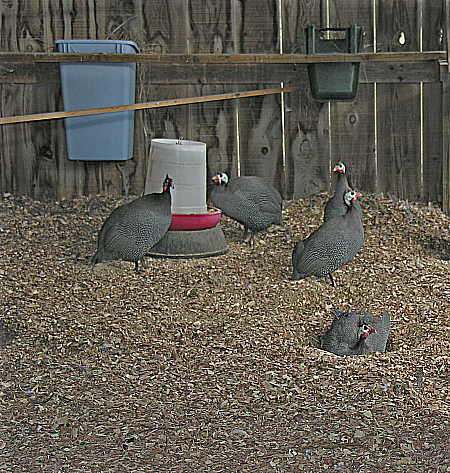
In the pastures (and stalls, if utilized) manure must also be dealt with. Mucking is not a particularly pleasant job, but it must be done on a regular basis. We do not stall our horses (except in medical emergencies), but the manure in the pasture must be managed for the control of flies. We have settled on the use of a tine-harrow (also called a field drag or scotch-harrow) to cope with the horse manure in our pastures, as pictured below.
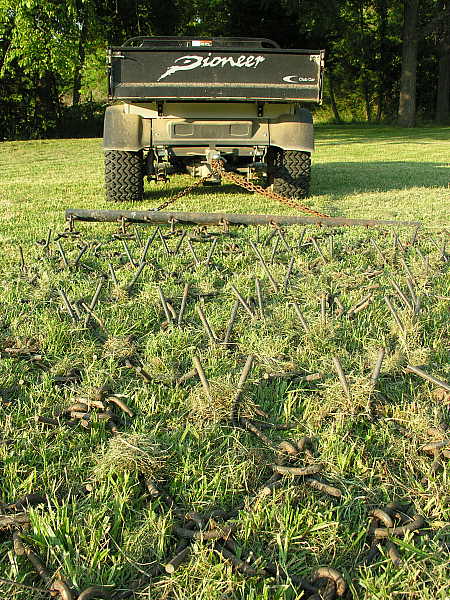
The use of the harrow serves several ends at one time: breaking up and spreading manure, which deprives flies of a breeding medium; fertilizing the pasture with the pulverized manure; and ensuring ground contact for germinating grass seed.
After all the manure management tasks have been accomplished, you may still find that a sizable population of flies exists. To handle the flies that do manage to exist, despite your best manure management efforts, safe, non-toxic remedies can be utilized. One method involves the use of our avian friends to help with fly control. Guineas and chickens love to eat flies, so keeping these fowl in your grounds will help alleviate a fly problem. Another species that will consume abundant quantities of flies, as well as other flying insects, is the Purple Martin (see previous post). By placing Martin houses along the perimeter of your pastures, as shown below, you will not only get to enjoy the aerial acrobatics of these wonderful birds, but you will be helping to control fly populations.
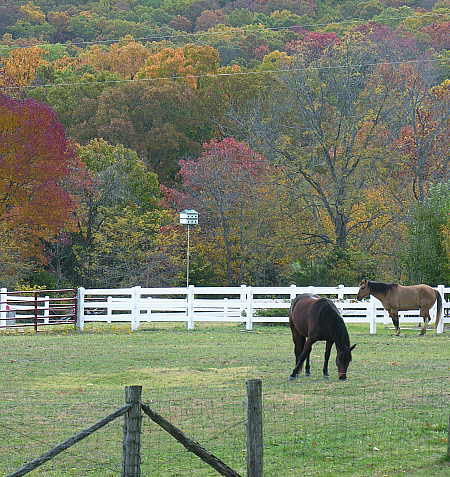
For those nasty biting flies that harass you and your horses, you can use a simple, but effective biting-fly trap, as pictured below.
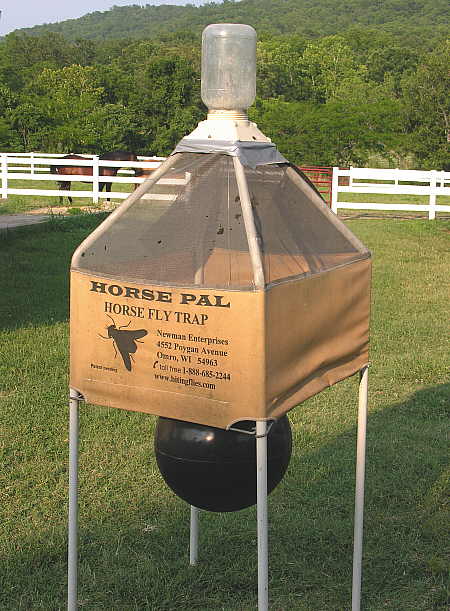
For all other types of flies, a safe disposable fly trap will work wonders. The type of trap we use consists of a container filled with water which is mixed with a non-toxic scent that attracts flies. Like the famous “Roach Motel”, flies can check in, but they cannot check out. Into the trap they fly, only to meet their doom through drowning or by being baked in the heat. It looks gross, but believe me, they work! When this trap is filled with flies, simply toss it and hang another.
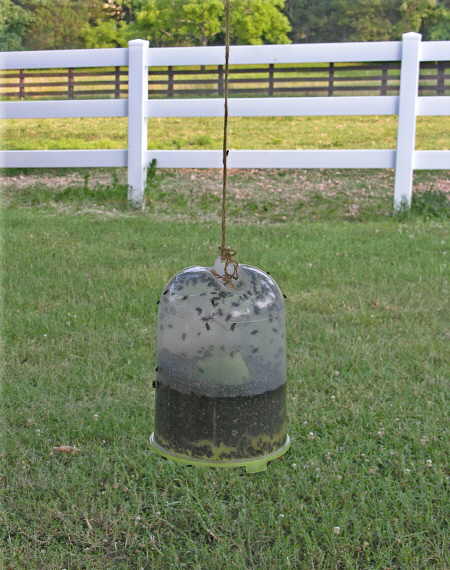
Using these, as well as other fly control methods that you may already know about, will hopefully lead to a more enjoyable holiday weekend for yourself, your family, and your friends, without those hordes of uninvited guests!



They do look gross, but I’m sure that the pros far outweigh the cons in this situation!
I remember HATING bug repellents when I was younger. My dad told me that if I didn’t want to be bit while out camping or wherever that my best bet was not to shower, or at least not to use any soap if at all possible. I tried that and it always worked! I’m not recommending going about unwashed for weeks at a time, but for a camping trip of only a few days (especially if you’ll be swimming during that time) it sure helps to keep the bugs off!
Very educational post – thank you very much 😀
Believe it or not, I actually HAVE seen the chemical lawn fertilizer guys spraying acres of manicured grass while wearing hazmat-type suits! And then they tell you that it is safe for your kids to go play on that lawn.
I have little doubt that if credible assertions were made that lawn chemicals were linked to cancer, the denial noise machine would gear up just as it had about global warming for so many years.
This was a worthy post, Hal. (Well, all of your posts are worthy!) It’s great to see thoughtfulness and resourcefulness expressed in a blog. Such a rare thing sometimes.
Great post! You’ll be proud to know that I finished our guinea house this weekend! A post on the subject is forth-coming!
First that was well said, clear, and informative. Our chickens were contributing to a high fly population here recently. I purchased one of those bag type fly traps and it has worked marvelously.
I took a photo of it yesterday to use in a brief post about it’s effectiveness, but you have covered it so well, I think I’ll pass.
Hal,
Could you give us more of a tour around your hen house? Having just recently built mine, I haven’t yet built any nesting boxes or places to roost. I’d be interested in learning more about the placement of things.
Unfortunately, I build my door swinging in, so unless I build a lip to hold back the mulch I won’t be doing that (else I won’t be able to open the door). I think I will build a lip and put cedar chips in the bottom as you have done. It sounds like a great idea! Thanks for sharing!
Pingback: Ranch Ramblins » Blog Archive » Welcome To Our Hen Houses
Pingback: Ranch Ramblins » Blog Archive » Will Today Be the Day?
Flies cost nearly $1 Billion in annual production loses to the U.S. dairy and beef industries according to the USDA. Flies also carry over 65 diseases that affect humans as per Pennsylvania State College of Agricultural Sciences. Flies Be Gone non-toxic fly traps have been in use around the world for over 10 years. Used by American Forces in Iraq and Afghanistan, the traps are in-expensive ($15US) and very effective for fly control. Visit my web site (www.FlyMaster.Biz) where you can purchase our traps at discount and for more information and photos of Flies Be Gone in use both in the US and in Iraq. We recommend purchasing our 2PAC Trial Kit. We gurantee you’ll be impressed!
Excellent website! Thank you for this opportunity!
Bert the FlyMaster
Pingback: Some Chores Are a Drag | Ranch Ramblins